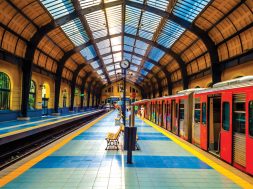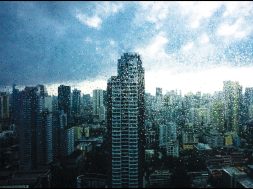Meeting Challenges Efficiently

As we take giant strides in infrastructure and allied sectors energy efficiency has already one of the chief areas for concern and as a responsible nation we need to address it.
Voltaire, one of the famous French writers said “With great power comes great responsibility” and thanks to Spider Man the proverb remains etched in the minds of the current generation. For a nation like India which is on an ongoing journey ‘from a developing to a developed nation’ this means a lot. With each passing decade our built environment will witness a massive growth in terms of skyrises, highways, commercial spaces, retail spaces and much more. Furthermore we are also the world’s second most populous nation after China, which puts a huge stress on the available energy resources. So it is needless to say that energy efficiency has to be at the heart of everything we build.
To be able to achieve the desired dose of energy efficiency, it is also essential that policy and implementation pertaining to energy efficiency is implemented. Khozema Chitalwala, Principal Architect, Designers Group points out “Most of the governing bodies are not very diligent about energy efficiency policies. The organization and people ready to invest in energy efficient realms are not getting enough subsidies or benefits from the authorities responsible. The need of the hour for the government is to look into related policies and encourage architects to function in this domain.” Achieving energy efficiency requires the right amount of effort and planning. Depending on the project at hand precise measures need to be implemented. For the projects yet to be constructed everything can be done from the scratch. As far as the existing projects are concerned a proper energy assessment is necessary. This assessment brings to light the energy excesses in the concerned project post which methods can be implemented for arresting these excesses.
Vikas Sabharwal, Director & Principal Partner of ivpartners, points out“Energy efficient buildingswhether newly constructed or renovated are designed to amplify reduction of the energy needed for heating and cooling, independently of the energy and of the equipment which will be chosen to heat or cool the building. Empathic design takes the long view beyond designing a single building. Methods like passive solar design, the use of renewable energy resources, net zero energy building, carbon emission reduction, envelope environment quality, green materials, efficient mechanical design and innovative structural systems are basic ways to make a building energy efficient. For instance, in order to achieve net zero energy in a new high rise building, first, multiple green solutions need to be evaluated using passive efficient energy generators.”
When it comes to building design earlier India primarily witnessed horizontal expansion, post globalization more and more high rises came into the picture. For a country where buildings would not rise above three floors, people started witnessing high rises which scaled up to 30 and 40 floors. So is imparting energy efficiency a challenge in this new age buildings? It is not, believes Khozema “Energy efficiency is not a challenge, but it is something which needs to be imbibed in designs, irrespective of the building being low rise or high rise although, the amount of energy consumption required for a high rise building profile is higher as compared to a low rise or an affordable one due to the less number of frills in an affordable envelope. Also, High rise projects utilise huge glass facades which also create an opportunity for energy harvesting.”
In buildings, the hospitality sector too accounts for a lot of energy consumption Mala Singh – Chairperson & MD -PEC Greening India says “Especially in luxury hotels and in the business of luxury otherwise, there is a misconception that correlates increased energy use with improved quality of services. I believe hotels can reduce the use of energy without compromising the high quality of services for guests and in the process benefit from cost savings. Managing energy use in the hotel is the first step towards this. Energy management helps in controlling the operating costs. This in turn adds to the profitability and increases the annual turnover of the hotel. The savings attained can be skillfully used to offset costs arising out of employee appraisals and purchasing additional amenities.”
EPC Companies play a major role in infrastructure building. Given their nature of work and expertise they too impart energy efficiency in this project “Our primary objective,” says Sandip De, General Manager Design and Build, Shapoorji & Pallonji Engineering and Construction,“has been to optimize on three major areas, electrical, air-conditioning heating and ventilation (HVAC) and water consumption in the building. Our next focus is controlling the air conditioning load of the built form through effective planning and design. Another area of focus is water conservation. Our buildings are designed as zero discharge element with the excess outflow from the final treatment plants being used as flushing or agriculture water and make up water for the cooling tower. The water balance diagram is created at the start of the concept layout and maintained till the end of the project. The fixtures selection is based on the flow parameters which enables us to reduce the water demand substantially.”
Prakasan TP, COO, MEP Business, Sterling and Wilson Pvt Ltd says“We deploy devices such as smart energy meters/ variable frequency drives throughout the project for high side key equipment and low side distribution panels which help us to analyse and understand the energy consumption of any equipment beyond its desired efficiency. These devices generally operate at an optimum frequency based on the demand/load. The demand/load is obtained from the inputs of various sensors installed at multiple locations depending on the equipment to be operated. The standards referred to during the design and engineering are -ECBC Energy Conservation Building Code. ASHRAE Standard 90.1 and 62.1-2016 (American Society of Heating, Refrigerating and Air-Conditioning Engineers), ECBC (Energy Conservation Building Code), GRIHA (Green Rating for Integrated Habitat Assessment). Moreover, we examine and take estimate of the required energy capacity of the projects and successfully reduce the actual energy requirements for functionality of building with the help of smart solutions which include Building Automation System (Including set of smart ICT sensors for monitoring & controlling the building services smartly) and Scheduling and sequencing the operation of high side Electrical, Mechanical equipment for load sharing with energy efficiency.
The use of energy efficient buildings is the need of the hour as the design of tall buildings warrants a multidisciplinary approach and requires the integration of architectural components, structure, vertical transportation, fire safety, energy conservation, and communication systems. But unless there’s integration of functions of urban local bodies (municipality, utility companies etc.) and capacity enhancement of individuals liable for implementation and monitoring, it shall still remain a challenge. So all the stakeholders including government need to work seamlessly to ensure we become an energy efficient nation.
21
Cookie Consent
We use cookies to personalize your experience. By continuing to visit this website you agree to our Terms & Conditions, Privacy Policy and Cookie Policy.









